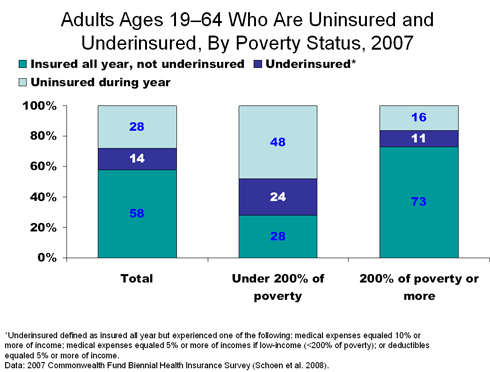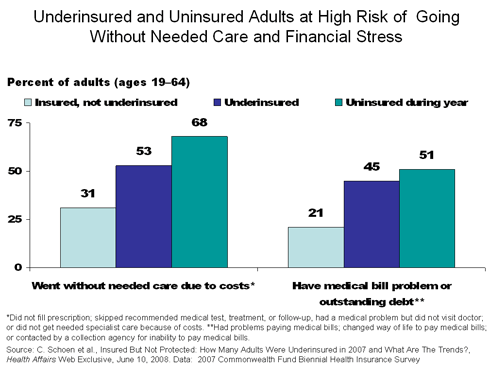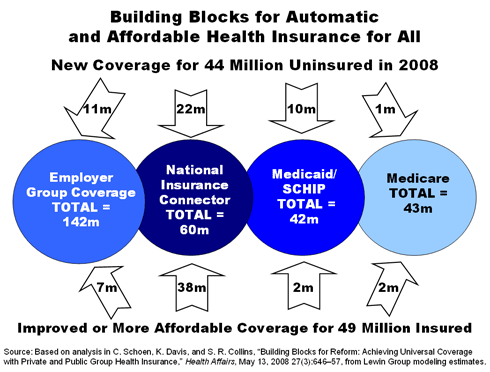By Karen Davis
The purposes of health insurance are to ensure financial access to needed care and protect against financial hardship from medical bills. Unfortunately, for many of those with health insurance, neither purpose is fulfilled. A Commonwealth Fund study published earlier this month in Health Affairs showed that 25 million Americans are underinsured, meaning they have health coverage but still have medical expenses they cannot afford. The number of underinsured has risen by 60 percent since 2003. When added to those who are uninsured at some point during the year, 42 percent of all adults—and 72 percent of those with incomes below twice the poverty level—are inadequately or unstably insured.

Unaffordable Care
According to the study, people who don't have adequate coverage have many of the same experiences as the uninsured. More than half of the underinsured (53%) and two-thirds of the uninsured (68%) went without needed care—including not seeing a doctor when sick, not filling prescriptions, and not following up on recommended tests or treatment. Only 31 percent of insured adults went without such care. Forty-five percent of the underinsured had a medical bill problem or medical debt, compared with 51 percent of the uninsured and 21 percent of the insured.

The problem has quickly worked its way up the income ladder. Since 2003, rates of underinsurance have tripled among middle-income Americans, or families making more than $40,000 per year.
The study authors, the Commonwealth Fund's Cathy Schoen, Sara R. Collins, Jennifer L. Kriss, and Michelle M. Doty, conclude that a variety of factors related to insurance design are responsible for this growth. Health insurance premiums have risen at a much faster rate than wages. And because of rising costs, employers are often selecting plans for their employees with benefit limits, such as a set number of physician visits or restrictions on the total amount a plan will pay for medical care. Plans available through the individual insurance market are even more likely to have such restrictions. The underinsured also were far more likely to report having high deductibles: one-quarter had annual per-person deductibles of $1,000 or more.
Well-Designed, Universal Coverage
The growing number of people with inadequate health insurance underscores the need for universal coverage that has comprehensive benefits. Such a system is feasible as spelled out in a "Building Blocks" framework described in another recent Health Affairs article, which I coauthored with Fund colleagues Cathy Schoen and Sara Collins. This framework sets forth a shared private–public solution that would benefit both the uninsured and the underinsured.
Under the Building Blocks framework, small businesses, the uninsured, and the self-employed could find coverage through a new national insurance connector that would offer a choice between a Medicare-like option with enhanced benefits, called Medicare Extra, and private plans. The premiums for Medicare Extra would be community-rated for everyone under age 60, estimated at $259 per month for single premiums and $702 per month for families in 2008. These premiums would be 30 percent lower than those generally charged for employer-sponsored plans because of Medicare's lower administrative costs and provider payment rates.
Other components of Building Blocks include: requiring that all individuals obtain health insurance, with automatic enrollment through the personal income tax system; a pay-or-play requirement for employers, who must cover their workers or contribute 7 percent of earnings up to $1.25 per hour; and expansion of Medicaid and the State Children's Health Insurance Program (SCHIP) to cover all low-income adults and children below 150 percent of the federal poverty level. The plan also involves scaled tax credits to offset premiums that exceed 5 or 10 percent of one's income as well as several Medicare reforms, such as the elimination of the two-year waiting period for people with disabilities and the option for adults over age 60 to buy in to Medicare.
This plan would achieve near-universal coverage, with 99 percent of the population participating. Forty-four million uninsured people would find affordable coverage – from employers, the national insurance connector, Medicaid/SCHIP, or Medicare. By building on the experience of Medicare and offering a Medicare Extra option to individuals and small firms, our plan would benefit the underinsured as well as those who are now paying much higher premiums. An estimated 49 million people would change coverage – finding lower premiums or better benefits through the insurance connector or public programs. By offering more choices, including the option of enrolling in public programs, all Americans would have the financial security that insurance is intended to provide.

We cannot accept a health care system in which 42 percent of Americans under age 65 are uninsured or underinsured. We must pursue a workable solution that mixes private and public coverage well before the majority of Americans find themselves with no coverage or coverage that has been chipped away until it no longer serves its purpose.
The Commonwealth Fund is interested in your feedback. Please take advantage of our commenting feature by clicking on the "Post a Comment" button. Select comments will be published on this page.

Written with the assistance of Christine Haran


